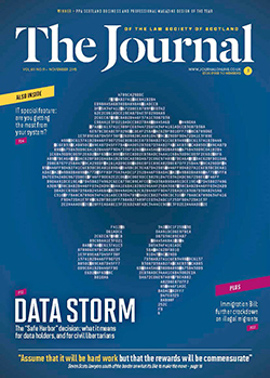How far can we rely on the register?

One of the biggest changes under the Land Registration etc (Scotland) Act 2012 is defining what constitutes an unchallengeable title. Under the 1979 Act, titles were either
This enhanced the curtain principle of the register, namely that there was no need to look behind the register. Reliance on the register was standard since it was what the land certificate said, rather than the underlying deeds, that took precedence. Some commentators felt that this principle formed the basis of “registration law”, which differed from the law of property. The 2012 Act has been described as a reassertion of the supremacy of property law by bringing registration law into line with property law.
With the new system based on
In this article, we outline the different types of title that are now possible and what is required for reliance on such titles.
What are the different types of title ?
There are now three main categories of title, namely:
- those registered under the 1979 Act;
- those registered under the 2012 Act; and
- those still unregistered.
Titles registered under the 2012 Act can be further
- (a) those registered following a registrable deed (typically a disposition);
- (b) voluntary registrations;
- (c) automatic plot registrations (APR);
- (d) Keeper induced registrations (KIRs); and
- (e) a non domino (s 43 prescriptive
claimant ) applications.
The reason that these subcategories may matter is because not all protections apply to all of these types.
How can we identify which type of registered title we have?
There are a few clues on title sheets:
- (a) If the date of first registration is before 8 December 2014, it will be a 1979 Act registered title. If after, it will be a 2012 Act registered
title . Although 1979 Act registrations are still being completed, their registration dates are backdated, so this is a simple rule to follow. - (b) APR titles will have reference to a lease, which will be registered on the same day as the title itself. Of course, this will only be the case for as long as that lease subsists.
- (c) KIR titles may be evident from either a statement that the proprietor is
unknown, or a KIR note in the consideration section. There is currently a consultation on KIR, and one of the questions it asks is whether it is useful to have a KIR statement on the title sheet, so final practice is yet to be settled. - (d) Section 43 (a non domino) titles will carry a “provisional” marking for 10 years until the requisite possession following registration has been evidenced. On occasion, other titles may also be marked provisional under s 81(3), where the fact that prescription is running comes to light at some point after registration.
When can we rely on the register?
The register can generally be relied
It is important to note that this article focuses on the “mud” rather than the “money”. In other words, we are simply considering reliance on the register in the sense of ensuring actual ownership and not just a financial compensation. We have considered each of the different areas below.
(1) Midas touch
For titles registered under the 1979 Act, the land certificate still carries the Midas touch as long as, on 7 December 2014, the title could not have been rectified against the owner. In effect, this means that on that date:
- (a) The registered owner possessed the property. There is a statutory presumption in the 2012 Act that they did, but as with all presumptions, this can be overturned with appropriate evidence.
- (b) The registered owner had not consented to a rectification.
- (c) The register was not inaccurate as a result of the registered owner’s fraud or carelessness.
Since it is unlikely anyone will attack the register by virtue of fraud or carelessness, the first two criteria are likely to be the main risks. These should, of course, usually be in the seller’s knowledge. Therefore, simple confirmation from a seller that they possessed on that date and that they did not consent to a rectification should de-risk any purchase, inasmuch as the solicitor has made
As time passes, it will become more and more difficult to prove that the register could have been rectified on 7 December 2014, so the transitional provisions will gradually become less important. When that happens will likely depend on the type of property: for example, rural march walls can remain in situ for a long time, whereas urban fences are more easily moved. Practice will no doubt evolve accordingly.
(2) Realignment
The 2012 Act introduces a new protection for 2012 Act registered titles known as “realignment”. Realignment is like the Midas touch, except that it is not automatic and it is deferred. Various criteria must be met before a purchaser can be so protected. Of course, if realignment does apply, it means that there is no need to look behind the register, just as with the Midas touch.
What are the criteria for realignment to apply?
Purchasers can rely on the register if the following realignment criteria are met. There are similar, though not wholly identical, criteria for protecting assignees of registered leases and grantees of servitudes.
- The seller was named on the title sheet as the registered owner.
- The purchaser is in good faith.
- There is possession openly, peaceably and without judicial interruption for a year. This means either that the seller possessed for a year up to the day before the purchaser acquires
title, or the seller and then the purchaser possess for a year between them with no gap. - During that
year the Keeper has not become aware that the register was inaccurate because of the seller (or purchaser) not being the true owner. - During that
year there has beenno s 67caveat on the title sheet relevant to the purchaser’s acquisition. - During that
year the title sheet hadno s 30(5) statement, i.e. that the Keeper does not know with certainty who the owner is. These statements are to facilitate KIRs, so KIR titles are more prone to challenge than other registered titles since realignment will be precluded by such a statement in some of them. - The Keeper granted warranty on the title sheet; and
- The disposition would have conferred ownership on the purchaser, had the seller been the true owner – so, for
example there is no ex facie invalidity in the disposition.
Again these circumstances are largely in the seller’s knowledge, so if realignment is required, a purchaser can ask the seller to confirm in the missives that these criteria have been met and will continue to be met until completion.
Not everyone can rely on realignment provisions. The first registered owner has no realignment protection. In other words, they cannot rely on the register. Their comfort is simply the
(3) Prescription
The law on
However, the 2012 Act amended the Prescription and Limitation (Scotland) Act 1973 so that all titles, regardless of whether recorded (
Again, possession here means openly, peaceably and without judicial interruption. This now applies whether or not the Keeper excluded her warranty/indemnity.
Under the changes, prescription now only applies where the registration is founded on a deed. It is the deed itself that prescription runs on, rather than the title sheet. This means that voluntary registration, automatic plot registration, and KIR titles do not act as
The fact that prescription runs on the deed has another interesting effect worth bearing in mind. If the Keeper registers a deed and does not give effect to the full property extent on the Land Register, for example, omitting reference to common parts for pragmatic reasons (PMP case scenarios and so on), prescription can still run on those areas as long as the owner was aware of his ownership
Where the parties identify that prescription is the only way to rely on the register, a simple confirmation in the missives of prescriptive possession should be enough to satisfy a
Reliance: still a principle
An understanding of the different types of title can be important for reporting on
Indeed, as can be seen above, there is still
In most cases, appropriate due diligence questions and missives can provide enough comfort to purchasers that the seller does own the property registered in their name and that the title is unlikely to be rectifiable against them. Even if none of the statutory protections as to the “mud” apply, that does not of itself mean that the seller does not own the land, simply that the chance of rectification against the owner is a bit higher. Rectification of the register against that person requires an inaccuracy in the register. Mere lack of one of the three statutory protections does not mean that the registered owner will ever actually face a problem from a neighbour with
In this issue
- Appropriate adults and defence agents: who does what?
- Buying from a housing association: why consent matters
- Harassment: a civil claim?
- A welcome abroad: EYBA in London
- Reading for pleasure
- Opinion: David Faith
- Book reviews
- Profile
- President's column
- ScotLIS gets the green light
- People on the move
- Storm over Safe Harbor
- Light on a murky world
- Southern horizons
- Mediation minefield
- Migrants: no way to turn?
- The technological edge
- As our suppliers see us
- More rules to grapple with
- Fraud and divorce – a Scottish Sharland?
- What future for employment tribunal fees?
- Heading for a showdown on hard won human rights?
- Taxing question of relief
- Scottish Solicitors Discipline Tribunal
- How far can we rely on the register?
- All part of the game
- Law reform roundup
- From the Brussels office
- Poverty: a new front in the war
- Damage limitation: working it out
- Ask Ash
- A lawyer's lament
- Appreciation: Michael Scanlan






